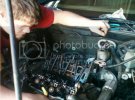13aceofspades13
lets kick some tires and lights some fires!
- Joined
- Oct 12, 2010
- Messages
- 2,292
Elm City Hobbies said:Zemmix said:Elm City Hobbies said:Don't listen to them Ace, Buicks are hot rods and were made to run, have at it buddy!
Hey now I speak as someone who once bought a set of x-drilled rotors (for my Toyota MR2). They did nothing. And actually they can be a potential safety hazard if you buy cheap ones.
http://www.ebcbrakes.com/cross_drilled_rotors/dangerous_cross_drilled_rotors.shtml
I wish I had saved my money and used it to buy more models instead! ;D
Yeah, I "do it yourself" set of cross drilled rotors....that is just dumb and asking for trouble.
Honestly...unless you have an open mag wheel that you just don't want an ugly normal rotor behind it, or you are going racing with your car, then cross drilled rotors have little effect on your braking.
The holes in them are better for cooling, and cosmetically look good, but just putting them for something to do is just a waste....I do have to agree with that
self drilling your own rotors is a dangerous thing to do, unless the rotor is designed that way, it greatly decreases the structural integrity, and can knock off the balance of the rotor.
slotting and cross drilling rotors does not just cool your brakes faster and add looks, it fights agents "Gas Fade" as the brakes get hot and as they start to spin fast, gasses are formed from the adhesives in the pads starting to get hot, with a smooth rotor this can cause a air pocket to form between the pads and the rotor, when you press on the brakes the pads float over the rotor over sort of a air film rather than coming in contact with the rotor, with slots and cross drilled holes this allows the gasses to escape effortlessly, eliminating gas fade.

